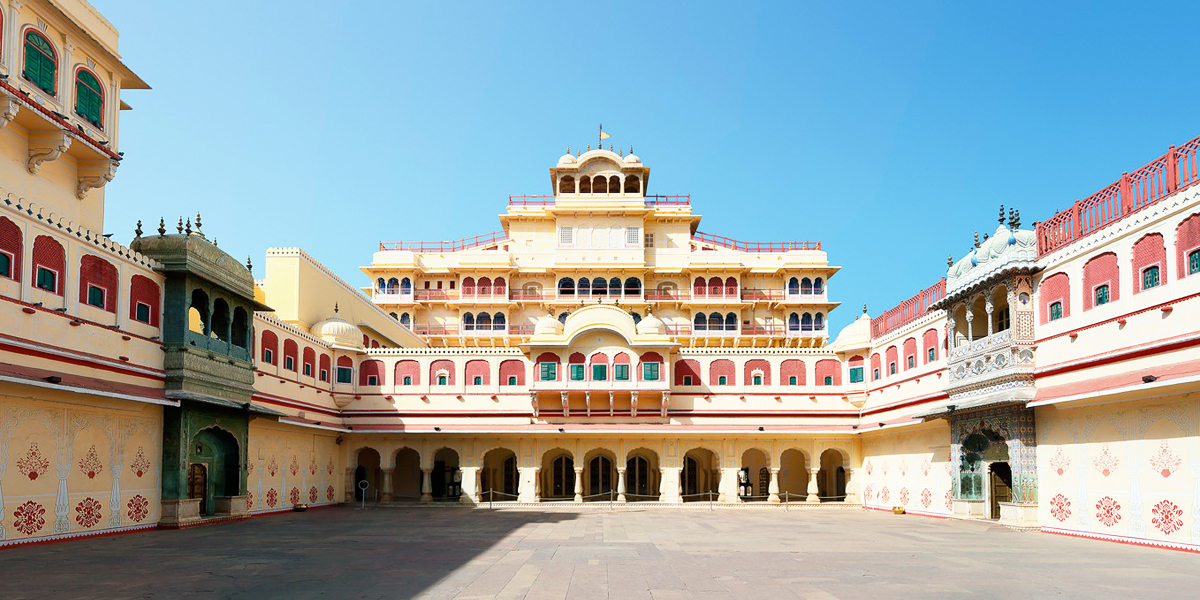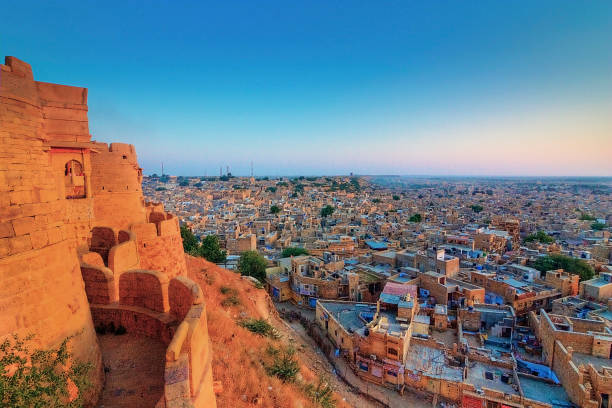City Palace in Jaipur
The city palace was built between 1729 and 1732 by the ruler of Amber Sawai Jai Singh II. The palace is located in the center of the Jaipur near Jantar Mantar and Hawa-Mahal.

Known for the remarkable past, City Palace Jaipur is one of the important places in the city. This heritage monument boasts the blend of Mughal, European and Rajputana architecture together and as a result, this palace stands out as a symbol depicting the richness and royalty of the Indian history. The City Palace Jaipur is actually a big complex located inside a portentous building with other halls, palaces, gardens, gateways and holy shrines. This place is actually built as a residence for the royal families.
City Palace, Jaipur was constructed between 1729-1732, in Jaipur as it paints the picture of heritage and rich culture. Sawai Jai Singh II has started the work of this palace, exclusively the exterior architecture of the building. Moving from Amber, he has moved to the Jaipur city because of the increase in water shortage problem which resulted in an inadequate supply of water to people. Further, he called Vidhyadhar Bhattacharya, a Bengali Architect who has designed the complex following the rules of Vastushastra which is why till today, City Palace is listed as the prime attraction of the state.
The City Palace, Jaipur contains pavilions, gardens, and temples of different shapes and sizes. There are huge gateways which provide entry to the complex like the Tripoli (Three gates), the Udai Pol and the Virendra Pol. While the latter two are open for public, the former one allows the royal families to pass through it. The essential highlights of the place include the Chandra Mahal, the Mukut Mahal, the Shri Govind Dev Ji Temple, the Maharani’s Palace, the Mubarak Mahal, and the City Palace Museum.
The City Palace was built by Sawai Jai Singh who is also known as the founder of Jaipur City. The credit of building Hawa Mahal and Jantar Mantar also goes to him.
Though the main architects behind the magnificent City Palace were Vidyadhar Bhattacharya and Sir Samuel Swinton Jacob, Maharaja Sawai Jai Singh also contributed to the architectural design of the palace.
There are three main gates to the palace which are Tripolia Gate, Virendra Pol and Udai Pol.
There are also four smaller gates in the third courtyard which are believed to represent four seasons.
The peacock or the Mor Gate represents the autumn season and there are 3D models of peacocks at the gate giving it a magical view.
The Lotus Gate was to symbolize the summer season while the Leheriya Gate for the spring season.
The Rose Gate is the winter gate. All these gates are decorated likewise and it is a sheer delight to just look at these gates, and entering it is bliss.
Today, there are two parts of the palace, one which is opened for the public and also has a museum, and the other for the residence of the royal family – the descendants who live here even now.
One of the famous items in the City Palace are two silver jars which have found place in the Guinness Book of World Records as the largest silver vessels in the world.
Apart from Mubarak Mahal and the Chandra Mahal, there are Pritam Niwas Chowk, Diwan-i-Aam, Diwan-i-Khas, Bhaggi Khana, Maharani Palace and the Govind Dev Ji Temple– an 18th century structure.
The Chandra Mahal, Maharani Palace and the Bhaggi Khana have been converted into museums.
Mubarak Mahal is a museum dedicated to royal textiles. You can see the dresses worn by queens and kings.
The clothes worn by Maharaja Sawai Madho Singh I is quite a treat to the eyes as he was believed to have weighed 250 kgs.
Baggi Khana is a place dedicated to chariots and coaches. The two prime attractions are the chariot which was used to carry the royal deity and a European Cab which was gifted to Maharaja Sawai Ram Singh II by Queen Victoria herself.
The Silehkhana has a great and fine collection of weapons and handguns used during the time. There are swords, knives, arrows, axes, and so on. The personal weapons of the kings are also displayed here.
9.30 AM to 5.00 PM (Day visit)
7.00 PM to 10.00 PM (Night visit)
Since the palace is divided into two parts - the museum and the royal family residence, there are two separate tickets that you need to purchase for each part. You can also take a composite ticket which is applicable for both the sections.
For the museum and exterior - INR 200 for Indian adults and INR 100 for children 5-12 yrs
For night visit- INR 500 for Indian adults, INR 250 for children 5-12 yrs, INR 1000 for adult foreigners, INR 500 for foreigner children 5-12 yrs
For a composite ticket- INR 300 for Indian adults and INR 200 for children 5-12 yrs, INR 700 for adult foreigners, INR 400 for foreigner children 5-12 yrs
For Royal Grandeur (Chandra Mahal tour) - INR 1500 for Indian adults and INR 1000 for children 5-12 yrs, INR 2000 for adult foreigners, INR 1500 for foreigner children 5-12 yrs
For Royal Splendor (special ticket) - INR 3000 for Indian adults and INR 1500 for children 5-12 yrs, INR 3500 for adult foreigners, INR 2000 for foreigner children 5-12 yrs
